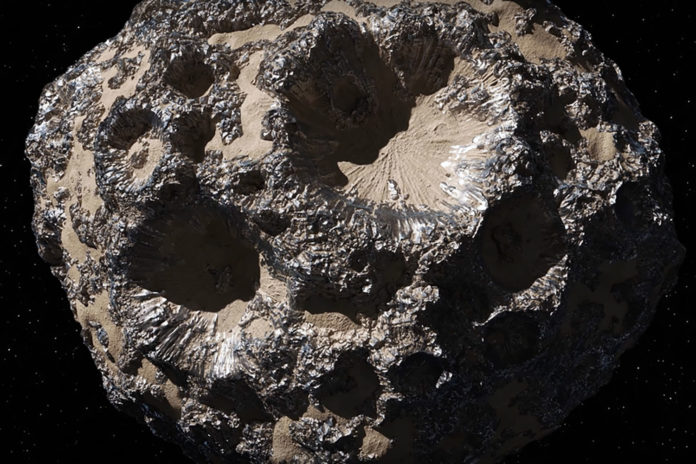Main-belt asteroid (16) Psyche is the largest M-type asteroid. Its surface is very heterogeneous. The asteroid has been a focus of numerous previous mapping efforts. Scientists have observed the asteroid using various telescopes to measure light emitted at infrared wavelengths, which carry information about Psyche’s surface composition. However, these studies could not spatially resolve variations in composition over the surface.
Planetary scientists at MIT and elsewhere have now offered an opportunity to see what the Psyche spacecraft might see. Based on the observations taken by a large array of ground telescopes in northern Chil, they have created the most detailed maps of the asteroid’s surface properties to date.
The maps reveal vast metal-rich regions sweeping across the asteroid’s surface, along with a significant depression that appears to have a different surface texture between the interior and its rim; this difference could reflect a crater filled with finer sand and rimmed with rockier materials.
The properties of Psyche’s surface were discovered to be unexpectedly diverse. The new maps provide insight into the asteroid’s history. Its rocky regions could be vestiges of an ancient mantle — comparable in composition to Earth‘s, Mars‘, and the asteroid Vesta’s— or the imprint of past impacts by space rocks. Finally, craters containing metallic material reflect prior research that the asteroid may have seen early metallic lava outbursts when its ancient core cooled.
Lead author Saverio Cambioni, the Crosby Distinguished Postdoctoral Fellow in MIT’s Department of Earth, Atmospheric, and Planetary Sciences (EAPS), said, “Psyche’s surface is very heterogeneous. It’s an evolved surface, and these maps confirm that metal-rich asteroids are fascinating enigmatic worlds. It’s another reason to look forward to the Psyche mission going to the asteroid.”
Scientists see the Psyche in finer detail, at a resolution of about 20 miles per pixel, thanks to the combined power of the 66 radio antennas of the Atacama Large Millimeter/submillimeter Array (ALMA) in northern Chile.
Kleer said, “The signals of the ALMA antennas can be combined into a synthetic signal that’s equivalent to a telescope with a diameter of 16 kilometers (10 miles). The larger the telescope, the higher the resolution.”
As it orbited and rotated within the asteroid belt on June 19, 2019, ALMA focused its complete array on Psyche. During this time, De Kleer gathered data and translated it into a map of thermal emissions over the asteroid’s surface, which the team published in a research in 2021. Shepard utilized the same data to create the most recent high-resolution 3D form model of Psyche, also published in 2021.
In this new study, scientists ran simulations of the asteroid to determine which surface properties might best match and explain the measured thermal emissions. In each simulated scenario, they set the asteroid’s surface with different combinations of materials, such as areas of different metal abundances.
By modeling the asteroid’s rotation, they measured how simulated materials on it would give off thermal emissions. They then looked for the simulated emissions that best matched the actual emissions measured by ALMA. That scenario would reveal the likeliest map of the asteroid’s surface materials.
Cambioni said, “We ran these simulations area by area so we could catch differences in surface properties.”
The detailed maps of Psyche’s surface properties show that the asteroid’s façade is likely covered in a large diversity of materials. Scientists also confirmed that overall, the asteroid’s surface is enriched in metals, but the abundance of metals and silicates varies across its surface. This indicates that the asteroid may have had a silicate-rich mantle that has since disappeared.
They also discovered that the material at the bottom of a significant depression — most likely a crater — changes temperature far faster than material along the asteroid’s rim as it rotates. This suggests that the crater bottom is covered in “ponds” of fine-grained material that heats up quickly, similar to sand on Earth, whereas the crater rims are made up of rockier, slower-to-warm materials.
Cambioni said, “Ponds of fine-grained materials have been seen on small asteroids, whose gravity is low enough for impacts to shake the surface and cause finer materials to pool. But Psyche is a large body, so if fine-grained materials accumulated on the bottom of the depression, this is interesting and somewhat mysterious.”
Simone Marchi, a staff scientist at the Southwest Research Institute and a co-investigator on NASA’s Psyche mission, said, “These data show that Psyche’s surface is heterogeneous, with possible remarkable variations in composition. One of the primary goals of the Psyche mission is to study the composition of the asteroid surface using its gamma rays and neutron spectrometer and color imager. So, the possible presence of compositional heterogeneties is something that the Psyche Science Team is eager to study more.”
Journal Reference:
- Saverio Cambioni, Katherine de Kleer, Michael Shepard. The Heterogeneous Surface of Asteroid (16) Psyche. DOI: 10.1029/2021JE007091
